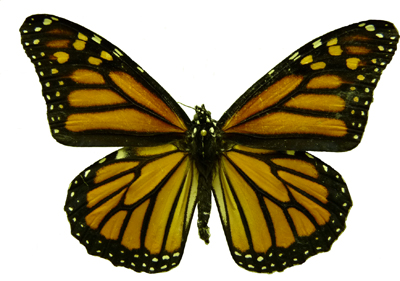 All summer we have seen the occasional orange and black monarch butterfly fluttering across our yards and fields. Coming into the fall, though, the numbers of these distinctive butterflies have increased and their colors have become more vivid and more intensely orange. These late summer monarchs are non-reproducing individuals who are about to begin a remarkable southerly migration. Over the next few months these insects will follow their instinctive flyways and end up deep in the mountains of central Mexico. There they will hibernate en mass in the isolated forests until the signs of spring arose them to begin their slow return to their northern ranges. None of them will ever return to their starting places, though. Several generations will be bred along the way in order to accomplish the long journey north.
All summer we have seen the occasional orange and black monarch butterfly fluttering across our yards and fields. Coming into the fall, though, the numbers of these distinctive butterflies have increased and their colors have become more vivid and more intensely orange. These late summer monarchs are non-reproducing individuals who are about to begin a remarkable southerly migration. Over the next few months these insects will follow their instinctive flyways and end up deep in the mountains of central Mexico. There they will hibernate en mass in the isolated forests until the signs of spring arose them to begin their slow return to their northern ranges. None of them will ever return to their starting places, though. Several generations will be bred along the way in order to accomplish the long journey north.
The mornings are increasingly foggy as summer begins to fade. These ground clouds are called “radiational fogs,” and they are caused by the extensive radiational cooling of the night air due to the longer, clearer nights of late summer. When the cool air comes into contact with soil and surface water systems that still retain their summer heat, moisture condenses into the fog. The warming sun in the morning quickly reheats the air and dissipates the fog.
Crab grass is one of those plants that is almost universally unloved. Several of my friends and neighbors, in fact, positively hate the species and do not want to hear anything good or amazing about it. In my rich mix of plants that I call my lawn, though, the rise of the crab grass is an exciting, late summer event.
Crab grass thrives in the heat and dryness of the late summer because of elegant adaptations in its cellular structure and molecular physiology. In most plants, the cells that carry out the two parts of photosynthesis (the “light reaction” that captures the energy in sunlight and makes both energy molecules and also the “waste” molecules of oxygen, and the “dark reaction” that uses carbon dioxide and the light reaction’s energy molecules to make sugars) are intermixed together. This allows effective contacts and transfers and lets photosynthesis run quite efficiently. When a plant becomes stressed by a lack of water, though, it closes its leaf pores (the “stomatae”). This stops the potentially fatal water loss but also shuts off the delivery of carbon dioxide to the “dark reaction” cells. There is, then, an imbalance between the “light” and “dark” reactions, and one of the consequences is that oxygen begins to build up inside the plant. This oxygen starts breaking down the functional molecules of the dark reaction (a process called “photorespiration”) and the photosynthetic rate (and the growth rate) of the plant plummets.
Crab grass avoids photorespiration by anatomically separating and isolating the cells that carry out the light and dark reactions. The dark reaction cells are sealed away from the air spaces inside the leaf, and the oxygen from the light reactions, then, cannot break down the dark reaction cell’s molecules. A system (involving the synthesis of a four carbon molecule (hence, a C-4 plant!)) that transfers carbon dioxide from the air spaces to the dark reaction cells then functions to keep the carbon chemistry of the dark reaction cell operating.
At temperatures above 30 degrees C (about 86 degrees F) a C-4 plant is 200% more efficient than the typically photosynthesizing plant (which is called a C-3 plant, by the way!). So, when you see the spiky heads of crab grass rising about the dead and dying grass plants around them, think about the biological elegance that allowed that event to occur! As Michael Crichton put it so well in “Jurassic Park,” “Life will find a way!”
